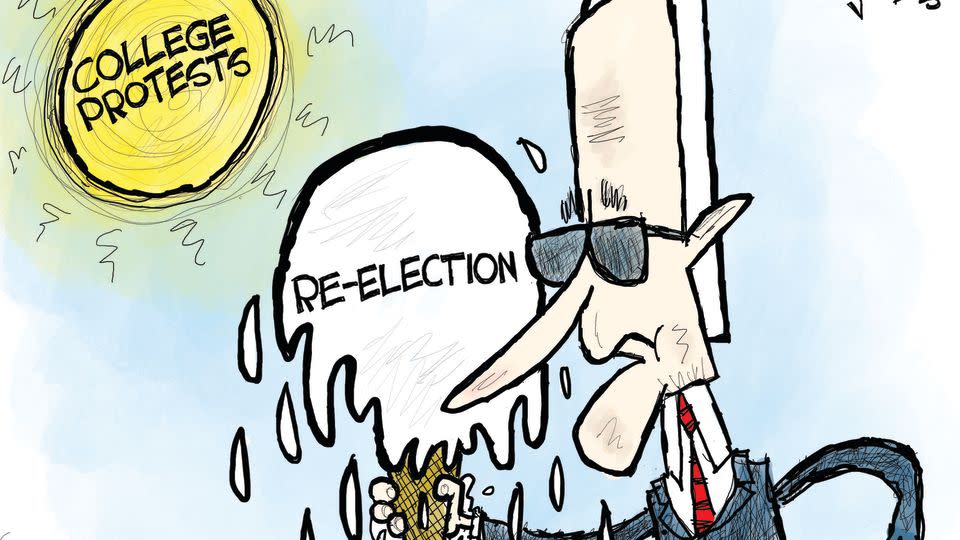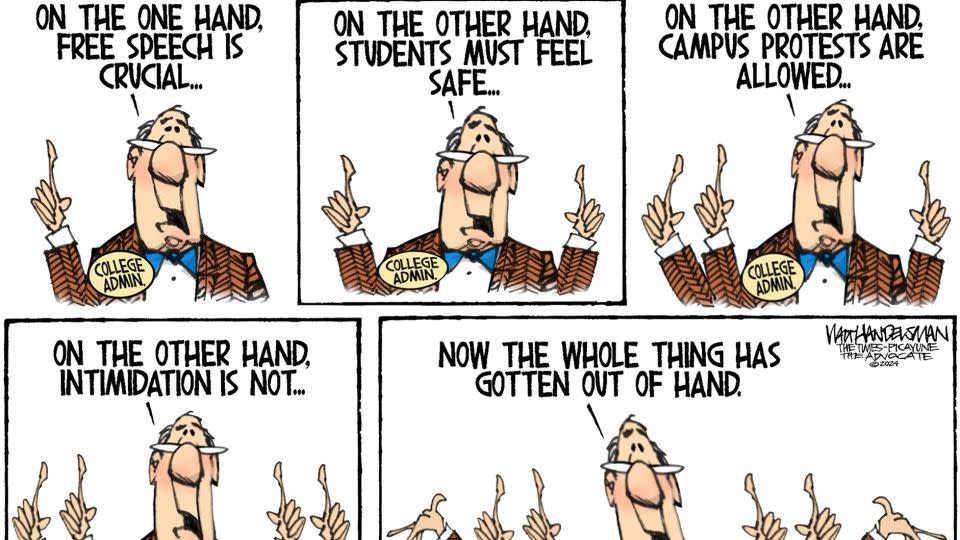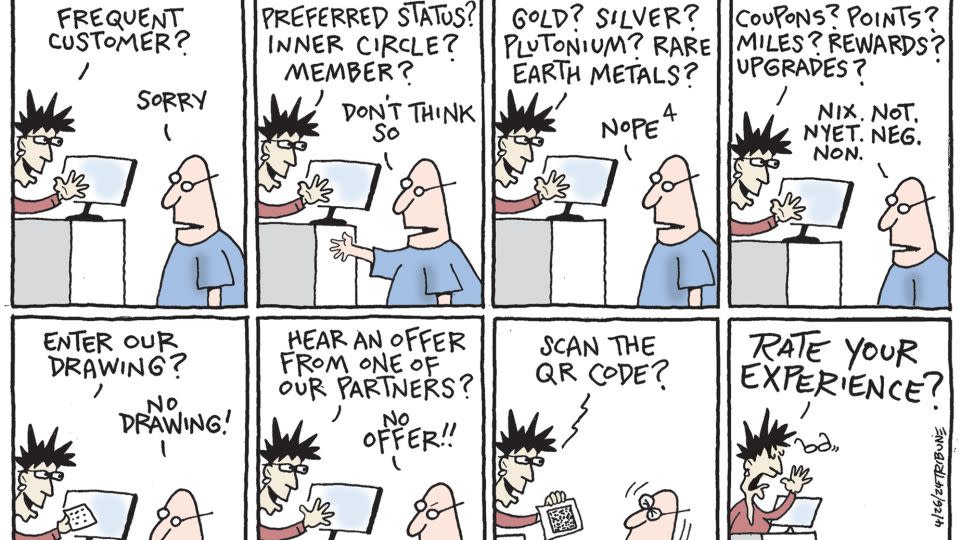Opinion: Donald Trump’s luxury
Editor’s Note: Sign up to get this weekly column as a newsletter. We’re looking back at the strongest, smartest opinion takes of the week from CNN and other outlets.
“A safe pair of hands is of paramount importance,” wrote William John Abbott Davies in his 1933 book, “How to Play Rugby Football.”
Davies had reason to know. He has been called one of the greatest rugby players of all time and was acclaimed for captaining England’s team to victory. The term “safe pair of hands” was coined to describe people skilled at cricket before it was applied to other sports, and then to politics.
Four years ago, many Americans saw Joe Biden as the ultimate “safe pair of hands,” whose decades of experience in government would help end the pandemic-induced chaos of then-President Donald Trump’s final year in office. That image of competence has been tested by a string of events since Biden moved into the White House: soaring inflation, surging migration across the southern border, a botched withdrawal from Afghanistan, Russia’s full-scale invasion of Ukraine, Hamas’ attack on Israel and the subsequent protests on US college campuses.
No president gets to choose the crises they’ll face, but each has wide leeway in how to respond. And since Trump is out of office, he has the luxury of criticizing Biden’s handling of the crises.
“After weeks of silence,” wrote Julian Zelizer, “President Joe Biden finally weighed in on the pro-Palestinian protests that have spread across college campuses nationwide. In his remarks on Thursday, Biden tried to walk a tightrope, mollifying two key campus constituencies: student protesters who are demanding that their universities divest from companies profiting from the Israel-Hamas war, and students who have been sounding the alarm of antisemitism on campus and the occupation of university property.”
“The speech won’t do much to improve Biden’s standing with the younger voters who have been disillusioned with the administration and unhappy with US support for Israel in its ongoing war against Hamas.” Polls show that Biden, who won 60% of voters between the ages of 18 and 29 four years ago, is trailing Trump by 11 points in the 18-34 age group.

Last week, Biden’s administration began the process of reclassifying marijuana as a less dangerous drug. He has also stressed the issue of abortion rights and moved to forgive about $160 billion in student loan debt.
“Certainly, Biden’s policy moves can have an effect, as polls show that young voters are more concerned about bread-and-butter issues like affordable housing and health care than they are about the Middle East,” Zelizer observed.
Yet Republicans moved swiftly last week to reap political gains from the campus protests.
“College quads have been turned into tent cities,” wrote Patrick T. Brown, “university buildings have been taken over by groups of students unfurling banners supporting intifada, and campus protests are pockmarked with calls for violence and antisemitism across the country. This gives Republicans an easy argument to make about why voters shouldn’t place Democrats in charge of our key civic institutions. The attack ads write themselves: If they can’t keep their ivy-covered campuses safe, how can they protect you?”
Jeremi Suri, a historian at the University of Texas at Austin, argued that the GOP’s attack on campus politics isn’t new — there’s a throughline reaching back to George W. Bush’s presidency.
“Some Republican leaders have spent the last two decades condemning everything about the universities that boosted their careers — the expertise on subjects like climate change, the values around diversity and inclusion and even the commitment to teach a full history of our country…”
“The time has come to end what has been a long political war on universities. It no longer benefits anyone, except those who truly want to destroy higher education and build their careers by repressing the free speech of young, talented citizens.”

For more:
David M. Perry and Matthew Gabriele: Student protests are what created the university as we know it
Peniel E. Joseph: What’s happening in Texas is an assault on American democracy
David A. Andelman: If Trump wins, I might leave America for good
Hussein Ibish: Unable to ‘win’ in Gaza, Israel sets its sights elsewhere

Nostalgia for Trump?
Six months from now, Americans will cast their ballots, rendering a judgment on how Biden has done — as well as how his candidacy compares to that of Trump and of third-party rivals like Robert F. Kennedy Jr.
As Scott Jennings pointed out, “The 2024 presidential election offers voters an unusual experience — not only is it a referendum on the incumbent, Americans will also be faced with the choice between two chief executives they know well: the current Oval Office occupant and his immediate predecessor.”
“And in comparison polling thus far, something fascinating is happening,” noted Jennings. “When presented with a polling choice, Americans seem to be yearning for the recent past, when they felt they were getting ahead instead of being sucked under by runaway inflation. Trump was the president then, and he’s benefiting from that nostalgia for better times now.”
Trade expert Stephen Craven noted that “US food prices have exploded since before the Covid-19 pandemic; they went up 25% between 2019 and 2023. The cost of going out to eat shot up even faster. So even as wage growth outpaces inflation, Americans at Kroger or Wendy’s are still feeling sticker shock.”
“Americans want relief. Former President Donald Trump and his policies, however, are not the answer. Trump will jack up your food bill.”
“Trump’s proposed tariffs will do immediate damage. He has called for a baseline 10% tariff on all imported goods. Given that the United States imports 15% of its food supply — including nearly all of its coffee and cacao, 60% of fresh fruit and nearly 40% of fresh vegetables — a 10% tariff would amount to a cost increase on some of America’s most important imports.”
Broken work culture
Technostress is “a very real and pervasive problem,” wrote author Brigid Schulte. “In an environment that has become increasingly demanding, technology has enabled late-night emails from the boss, texts and pings from co-workers at all hours, and made work ever-present in our lives. That techno overload, invasion into our personal time and constant connectivity leave the brain and body unable to disconnect and rest.” The consequences for health, relationships and family life can be profound.
“A work culture that implicitly expects all-hours work devotion, and leaders who never take vacations or send late night and weekend communication, even if they say not to respond, makes it difficult for individuals to do anything other than conform. Otherwise, they could risk being seen as not committed, passed over for promotion or worse, let go.”
Legislators are taking note, looking for ways to shield people from after-hours work. France passed the first “right to disconnect” law in 2017 and other nations have followed suit. California is considering a bill that would require companies to publish plans to clearly set out working and non-working hours, but as Schulte noted, a study found that the results of such laws are mixed. “Because governments don’t intervene in how organizational policies are written, and don’t enforce them, whether they work depends very much on the will of individual employers.”
Trump in contempt
The judge in Trump’s New York trial held him in contempt of court, ruling that the former president violated a gag order that bars him from making public statements about witnesses, jurors, court staff and others. Justice Juan Merchan fined him the maximum $9,000 for nine Truth social and campaign website posts, and ordered the removal of the posts, which Trump did. As Norm Eisen noted, “the judge also warned Trump that if he persists in violating the gag order, he faces jail time.”
“Before the trial began, Trump essentially dared the judge to incarcerate him, claiming jail time would make him a ‘modern-day Nelson Mandela.’”
“If Trump continues, the judge should take him up on it. For Merchan to bring this to an end, he may have to give Trump a night behind bars, following with longer stays in the ‘clink,’ in Trump’s words, until he honors the judge’s order.”
Eisen is providing his take on the trial from inside the courtroom, noting that former Trump aide Hope Hicks and attorney Keith Davidson helped prosecutors by bolstering their case that Trump falsified business records, hiding the reimbursement of hush money payments in order the influence the election. (Trump’s lawyers argue that he did not commit any crimes and that the charges never should have been brought.)
The Weinstein factor
Jim Walden and Deanna Paul, two former prosecutors who practice law in New York, wrote that Merchan was at risk of giving Trump the means to swiftly toss out a potential conviction in the case. “Merchan agreed to let prosecutors question Trump about his recent gag order violations and courtroom loss to New York Attorney General Letitia James … They also plan to ask him about a case he lost last year after writer E. Jean Carroll successfully sued the former president for defamation and sexual assault.”
“Prosecutors are making a grievous mistake, as is Justice Merchan. None of the above-mentioned acts has anything to do with the Manhattan hush money payments. Trump is not on trial for being a morally bankrupt person. He is on trial for using false records to conceal election interference. Other bad acts, even those he was found liable for, are beside the point.”
“The prosecutors and the judge have put the former president in an untenable position. The Constitution gives him the right to testify in his own defense — or not to take the witness stand if he chooses. He has said he wants to testify.” Walden and Paul argued that the issue is the same one that led a New York appeals court to toss out Harvey Weinstein’s sex crimes conviction.
In the Weinstein case, prosecutors introduced evidence of other alleged victims to try to bolster their case, a response to a long history of discounting the testimony of accusers, wrote law professor Deborah Tuerkheimer. “Within and outside the criminal justice system, credibility is often reserved for those who come forward in numbers.”
“This reality may help explain the trajectory of Weinstein’s case. When one woman first reported that Weinstein had sexually assaulted her in 2015, her case went nowhere; when dozens of women ultimately came forward, Weinstein became the stand-in for #MeToo abusers — and he was prosecuted.”
Kristi Noem’s revelation

South Dakota Gov. Kristi Noem seems to have endangered any chance she had of becoming Trump’s running mate by revealing in a new book that she shot her 14-month puppy, Cricket, because the dog was “untrainable.”
There were many theories about why Noem chose to share this eyebrow-raising story years after it happened, with Dean Obeidallah pointing out that Trump was the first president in 120 years not to have a pet dog in the White House. But Obeidallah observed that a more likely explanation is “that she possibly thought that telling the story would endear her to a certain breed of heartless Republican, convincing them of her toughness. If that was Noem’s calculation, she might have made a grave miscalculation.”
A very different Census
Federal officials are crafting a major change in the way race and ethnicity are viewed in America. CNN Opinion’s Cristian Arroyo-Santiago reached out to a range of experts to assess the plan.
“If you’re a self-identified Hispanic or Latino, or a Middle Eastern or North African (MENA) person in the US,” he wrote, “chances are that every 10 years answering the Census gives you pause.”
Until now, Latino respondents were only able to select their identity as an ethnicity as opposed to a race. “According to 2020 Census Bureau data, of the 54.6 million Americans who reported that they identify as Hispanic or Latino, 43.6% either did not respond to the race question or responded by selecting the ‘Some Other Race’ option, a category that’s not federally recognized. As for the 3.5 million MENA people in the country, they are classified as White — a racial category many don’t see themselves represented by.” Going forward, “the two most controversial changes are the introduction of a combined question for race and ethnicity and the addition of two categories — MENA and Hispanic or Latino — as possible answers to that single question.”
Robyn Autry, a sociologist at Wesleyan University, wrote, “There’s no getting racial labels right, at least not in any technical or biological sense. Instead, we try to get their political significance right and to capture how these terms are actually used and lived. It has never felt right to say that an Arab American is white, or that some people must belong to racial and ethnic groups. Our feelings about these labels and identities, including who ought to claim them and using what criteria, change with time because race is ‘a human-invented, shorthand term’ that never fully corresponds to differences we think we see like skin tone and hair texture.”
Arturo Vargas, CEO of the National Association of Latino Elected and Appointed Officials, welcomed the change: “Although this approach must be done correctly to fully account for our racial and ethnic diversity, with this new path forward, we now have the opportunity for a better way to collect data on Latinos.”
Scholars Nancy López and Alan Aja criticized the change, saying the separate race and ethnicity options for Latinos provided crucial data that will be obscured under the new standards: “Asking about race/visual status and ethnicity/cultural heritage in the same question results in statistical gaslighting, promoting the myth of a post-racial America. How else will we know if we have eradicated the color line in social outcomes? Making Hispanic/Latino ethnicity a co-equal category with race is not the answer.”
Journalists and freedom

“In a shaded wood outside Bayeux in Northern France,” wrote Jon Williams, “a series of white memorial stones record the names of more than 2,000 journalists who paid the ultimate price while reporting on assignment since 1944. Among them are fathers and mothers, husbands and wives, daughters and sons as well as friends who never came home.” Williams, a former BBC and ABC foreign editor, is the executive director of the Rory Peck Trust, which supports freelance journalists and their families in crisis.
“All too often, the killers of journalists get away with murder. In almost 80% of cases, the families of slain journalists never see justice. For the corrupt and those abusing power, the ultimate form of censorship is silencing reporters, such as British freelance journalist, Dom Phillips (one of 40 names last year added to Bayeux’s white stones),” wrote Williams. In 2022, Phillips and his guide were shot dead while investigating allegations of illegal mining, fishing and logging in Brazil.
World Press Freedom Day was observed Friday. Despite its rigors and risks, journalism still appeals to young people around the world. As a high school freshman, aspiring journalist Quinn Mitchell has already stirred things up on the campaign trail in his state of New Hampshire. The 16-year-old wrote that he was removed from two events held by GOP presidential candidates.
“My experiences are just part of a disturbing trend. Gen Z journalists are often shut down by authoritative figures and officials, and student journalists across the country are not guaranteed complete constitutional First Amendment protection — discouraging active participation from students and rousing fear of litigation.”
“I plan to do my part by practicing amateur journalism anywhere I can. I want to encourage my generation to participate in the process, to take their seats and to ask the questions that politicians seem most eager to avoid. It’s our legacy, right and responsibility.”
Don’t miss
Sara Stewart: This Netflix show is hard to watch. That doesn’t diminish its message
Robert M. Lee: America’s small-town water systems are global cyber targets. Is your city next?
Denise Rucker Krepp: My family lost the Civil War. Last year they finally lost this vestige of power
Jill Filipovic: A law protecting pregnant Americans passed with bipartisan support. That’s not enough for these Republicans
AND…
Airline point deflation

Does it seem like your airline points are worth less now? Ganesh Sitaraman and William J. McGee looked at the evidence.
“To many flyers, point systems seem terrific, and their logic simple: They are like the punch card at a cafe where your 11th coffee is free. … But beneath the surface, airline point systems are rife with extractive, abusive policies that, in many cases, allow the airlines to deceive consumers and pocket their cash without giving them any real ‘rewards.’”
“How much are your points worth?” That’s a difficult question to answer, partly because some airlines are no longer posting redemption charts, according to Sitaraman and McGee.
“This lack of transparency means that airlines can change the value of points anytime they want. And if an airline drops the value of the points, that means that passengers effectively pay more in points for flights. Indeed, a recent survey found that, since 2019, the prices of airline rewards have increased faster than the rate of inflation, even as the benefits of rewards have decreased.”
For more CNN news and newsletters create an account at CNN.com

 Yahoo News
Yahoo News 
